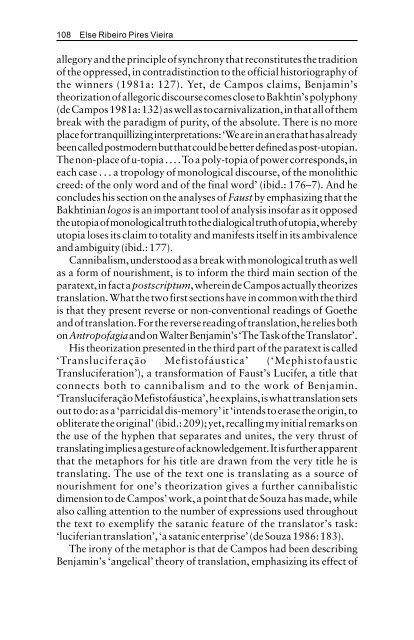post-colonial_translation
post-colonial_translation
post-colonial_translation
You also want an ePaper? Increase the reach of your titles
YUMPU automatically turns print PDFs into web optimized ePapers that Google loves.
108 Else Ribeiro Pires Vieira<br />
allegory and the principle of synchrony that reconstitutes the tradition<br />
of the oppressed, in contradistinction to the official historiography of<br />
the winners (1981a: 127). Yet, de Campos claims, Benjamin’s<br />
theorization of allegoric discourse comes close to Bakhtin’s polyphony<br />
(de Campos 1981a: 132) as well as to carnivalization, in that all of them<br />
break with the paradigm of purity, of the absolute. There is no more<br />
place for tranquillizing interpretations: ‘We are in an era that has already<br />
been called <strong>post</strong>modern but that could be better defined as <strong>post</strong>-utopian.<br />
The non-place of u-topia . . . . To a poly-topia of power corresponds, in<br />
each case . . . a tropology of monological discourse, of the monolithic<br />
creed: of the only word and of the final word’ (ibid.: 176–7). And he<br />
concludes his section on the analyses of Faust by emphasizing that the<br />
Bakhtinian logos is an important tool of analysis insofar as it opposed<br />
the utopia of monological truth to the dialogical truth of utopia, whereby<br />
utopia loses its claim to totality and manifests itself in its ambivalence<br />
and ambiguity (ibid.: 177).<br />
Cannibalism, understood as a break with monological truth as well<br />
as a form of nourishment, is to inform the third main section of the<br />
paratext, in fact a <strong>post</strong>scriptum, wherein de Campos actually theorizes<br />
<strong>translation</strong>. What the two first sections have in common with the third<br />
is that they present reverse or non-conventional readings of Goethe<br />
and of <strong>translation</strong>. For the reverse reading of <strong>translation</strong>, he relies both<br />
on Antropofagia and on Walter Benjamin’s ‘The Task of the Translator’.<br />
His theorization presented in the third part of the paratext is called<br />
‘Transluciferação Mefistofáustica’ (‘Mephistofaustic<br />
Transluciferation’), a transformation of Faust’s Lucifer, a title that<br />
connects both to cannibalism and to the work of Benjamin.<br />
‘Transluciferação Mefistofáustica’, he explains, is what <strong>translation</strong> sets<br />
out to do: as a ‘parricidal dis-memory’ it ‘intends to erase the origin, to<br />
obliterate the original’ (ibid.: 209); yet, recalling my initial remarks on<br />
the use of the hyphen that separates and unites, the very thrust of<br />
translating implies a gesture of acknowledgement. It is further apparent<br />
that the metaphors for his title are drawn from the very title he is<br />
translating. The use of the text one is translating as a source of<br />
nourishment for one’s theorization gives a further cannibalistic<br />
dimension to de Campos’ work, a point that de Souza has made, while<br />
also calling attention to the number of expressions used throughout<br />
the text to exemplify the satanic feature of the translator’s task:<br />
‘luciferian <strong>translation</strong>’, ‘a satanic enterprise’ (de Souza 1986: 183).<br />
The irony of the metaphor is that de Campos had been describing<br />
Benjamin’s ‘angelical’ theory of <strong>translation</strong>, emphasizing its effect of


